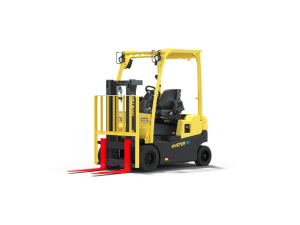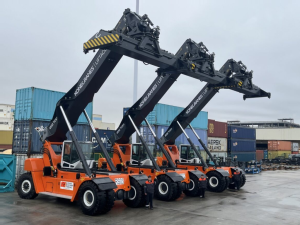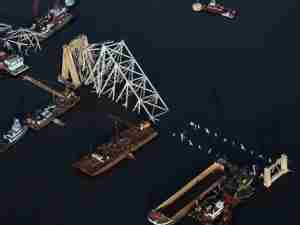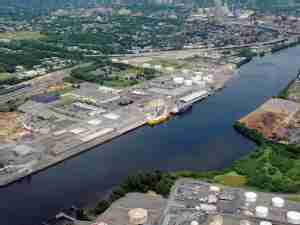Throughput for the Port of Rotterdam up 1%
posted by AJOT | Jan 20 2015 at 11:43 AM | Ports & Terminals
In 2014, the throughput in the port of Rotterdam went up 1% to 445 million tonnes. The different market sectors performed quite dissimilar. The container sector, up by 5.8% (volume) and breakbulk, with 12.1% growth, did exceptionally well. Oil products fell the most, by 8.1%. An extra 4.8% of crude oil passed through the port. Dry bulk fell by 0.7%. Allard Castelein, Port of Rotterdam Authority CEO: “In 2015 we expect the same growth in throughput as last year: 1%. This year too, the main growth is expected in the container sector. In the coming years, we will nurture the large, existing sectors in the port, whilst also focusing strongly on innovation and broadening the range of activities in the port. We need both for a healthy future.”
During this annual presentation, Castelein also paid plenty of attention to the challenges facing the port. “We are seeing major changes not only in the energy sector and the chemical industry, but also in logistics”, according to Allard Castelein. “So that the port can continue to be a strong pillar of our prosperity in the long term, we are working with business on innovation and on broadening the range of activities in the port. We can already see evidence of this in the increase in offshore activities, but the energy and chemical sector also need to become more sustainable. We are focusing on increasing efficiency in industry and on developing bio-based industry. For the container sector the development of the hinterland connections is particularly important. This year the new container terminals on Maasvlakte 2 will be busy starting up; from 2016 onwards, however, there will actually be extra capacity for further growth.’’
Minimal Fall in Dry Bulk
Dry bulk throughput fell in 2014 by 0.7%, to 88.6 million tonnes. The German steel industry ran at 87% capacity last year. Due to such factors as the renovation of blast furnaces in Germany, 5.2% less ores and scrap was handled in Rotterdam. Coal throughput fell by 0.9%. Although the throughput of cokes coal for the steel industry tends to be in line with that of ores and scrap, this increased in 2014 as a result of the concentration of incoming trade via Rotterdam. That positive effect was more than offset, however, as less coal for power plants was needed due to the mild winter and the increase in the generation of renewable energy in Germany. Agribulk throughput was up by 9.2%, mainly because more wheat was exported and, at the same time, more corn and soya were imported. The category other dry bulk consists mainly of raw materials for construction and industry. 6.8% more of these goods were handled, primarily as a result of the upturn in the global economy.
Fall in Liquid Bulk
Liquid bulk throughput fell by 2.1% to 202.5 million tonnes. This market sector accounts for 45% of total throughput in Rotterdam, so a limited decline can have a big impact on the total throughput figure. Crude oil throughput was 4.8% up. There were fewer maintenance shutdowns at the refineries and the capacity utilisation was higher. The category mineral oil products fell the most in 2014, by 8.1%. The most significant factors were the competition from new tank terminals in other ports and a decline in the handling of naphtha. The latter is an important feedstock for the chemical industry. This sector is battling against difficult market conditions in Europe. Actually, there has been strong growth in the throughput of oil products during the last ten years: in 2014, despite the decline, more than twice as many mineral oil products were handled than in 2004. LNG throughput is still modest in scale (1.2 million tonnes), but did experience tumultuous growth of 59.5%. This was due primarily to the re-export of LNG. The category other liquid bulk consists mainly of chemical products. The main reason behind the 7.4% decline is the fact that the European chemical industry finds it difficult to compete with that overseas. Energy and feedstocks are considerably cheaper elsewhere in the world.
Containers and Breakbulk Show Sharp Growth
There was a 5.8% increase in container throughput, to 12.3 million TEU (numbers) and a 5.2% increase to 127.6 million tonnes (weight). This sharp rise can be explained by a combination of factors. The economy in both the Eurozone and the United Kingdom is improving. As a result, there has been an increase particularly in the deepsea volumes on the shipping routes to Asia and North America. Moreover, the initial effects of the increase in scale in container shipping became visible: Rotterdam is an attractive port for the ever larger ships.
Breakbulk is a combination of roll on/roll off (ro/ro) traffic and other mixed cargo. Throughput in this category increased by 12.1%, to 26 million tonnes. Ro/ro traffic was up by 8.1%, thanks largely to the improvement in the British economy. In the category other mixed cargo, steel, non-ferrous metals and project cargo did particularly well. Other mixed cargo, for years on the decline as more and more cargo disappeared into containers, did exceptionally well, with 28.1% growth.









